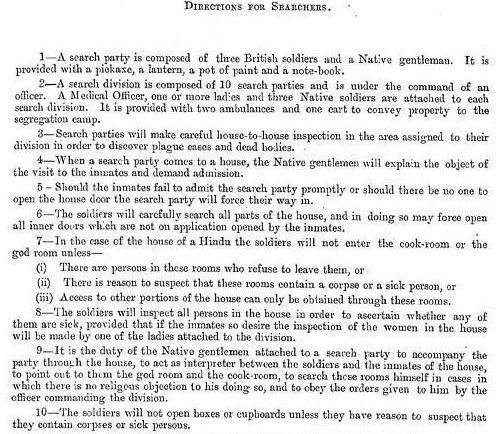Hong Kong in May 1894 was rife with bubonic plague. Within a short time, this extremely deadly and virulent epidemic had claimed a few hundred lives. Hong Kong was a busy port city with ships travelling out carrying valuable cargo and many people every day. Seaborne, the plague soon arrived in Bombay (Mumbai), a city which even in those days housed over 820,000 people. How did Bombay survive?
In the history of the world there have been three truly terrible outbreaks of Bubonic plague. The first was in 542 CE in Constantinople which killed 75 million people over two centuries. Then in the Middle Ages it hit Europe and the near east as the infamous Black Death, killing a third of the population. Finally, in the 1850s a third wave of plague hit Asia.

In 1894, when Hong Kong had its first deaths, the city’s administration rushed to try and contain it. Houses were checked, anyone with a leaky nose quarantined, and large parts of the city were disinfected regularly. That might have contained the disease in the city. The problem was that Hong Kong was a port city. Several ships carrying men and women infected with the plague had left Hong Kong long before anyone had even realised the plague might be a problem. Many of those ships headed straight for Bombay.
These ships were carrying huge amounts of money, all made through the trade of opium- the stuff that Bombay was built on. When they arrived at Bombay’s ports, these ships, with all their cargo and crew were given a clear path straight into the city.
The first recorded case of the plague in Bombay was in September of 1896, in the Mandvi port area (present day Ballard estate). It was discovered by Acacio Viegas, the president of the Bombay Municipal Corporation and a medical doctor. From Mandvi, the plague spread like wildfire. The port area was just perfect for the plague. Houses were poorly constructed, drainage systems unhygienically planned, and garbage improperly disposed. By the end of 1896 one thousand nine hundred people were dying – every week. And by the beginning of the new century, the plague had claimed 2.9 million people in the Bombay presidency alone.

In 1896 though, there was still hope that the disease could be contained. The local government jumped into action. Just like in Hong Kong plague victims and possible victims were segregated, large parts of the city were shut down, movement into and out of the city was carefully watched. But none of this was done with a gentle hand. There are stories of people being dragged off trains, suspected victims being locked up, and people being forced out of their houses. The result? A very distrustful general public. The various rumours that spread didn’t help either.
One such rumour was that the doctors were using the plague as an excuse to kill people and extract a rare oil from their bodies. Naturally, people didn’t want to go anywhere near doctors. One account says that when doctors tried to take a sick Hindu houseboy from the Parsi household he worked in, the Parsi women of the house – all 13 of them – gathered around the boy with knives drawn. They threatened to kill themselves if the doctors so much as touched the boy.
If that wasn’t enough to deal with, thousands of people fled Bombay in those early years. Nearly four hundred thousand people, by one count. And many of them took the plague with them. Predictably the plague spread.

It could however have been much worse. But in Bombay, there was a group of doctors and researchers, busy trying to understand the disease and find a cure. Finally, the first vaccine for bubonic plague was discovered in Bombay. W. M. Haffkine, famous for creating the inoculation against cholera, travelled to Bombay from Calcutta at the request of the British government. He set up a lab on Grant road and got to work. A cure proved impossible, but by January of 1897 he had created a successful vaccine. But that did not mean an end of the plague. For the next two decades, outbreaks continued across the country. By the time of the last outbreak in 1923, 100 million people had lost their lives. The Haffkine Institute continues to do ground-breaking work on infectious diseases, in Parel in Mumbai.
Mumbai has survived to tell this tale and many others. Join Storytrails on The Bombay Story, a journey of discovery into what built this formidable city. To book, write to [email protected] or call +919152021278.
Archives
- January 2022
- December 2021
- November 2021
- August 2021
- March 2021
- February 2021
- January 2021
- December 2020
- November 2020
- October 2020
- September 2020
- August 2020
- April 2020
- March 2020
- February 2020
- January 2020
- November 2019
- October 2019
- September 2019
- August 2019
- July 2019
- June 2019
- August 2017
- February 2017
- January 2017
- October 2013
Featured Posts
- Tales that pots tell: Keeladi excavations AUGUST 18, 2021
- The Last Grand Nawab: Wallajah FEBRUARY 10, 2021
- How Tej Singh became Raja Desingu of Gingee FEBRUARY 5, 2021
- How Shahjahan seized the Mughal throne JANUARY 28, 2021
- Alai Darwaza – Qutub Minar Complex, Delhi NOVEMBER 21, 2020
- Marking History through British buildings NOVEMBER 17, 2020
- The last great queen of Travancore NOVEMBER 7, 2020
- Brahmi and the evolution of scripts OCTOBER 15, 2020
- The Cambodian King of Kanchipuram OCTOBER 14, 2020
- James Prinsep – the man who read the writing on the wall OCTOBER 10, 2020
- Mariamman – the Village Goddess who travelled SEPTEMBER 30, 2020
- Misnamed Monuments of Mamallapuram SEPTEMBER 28, 2020








